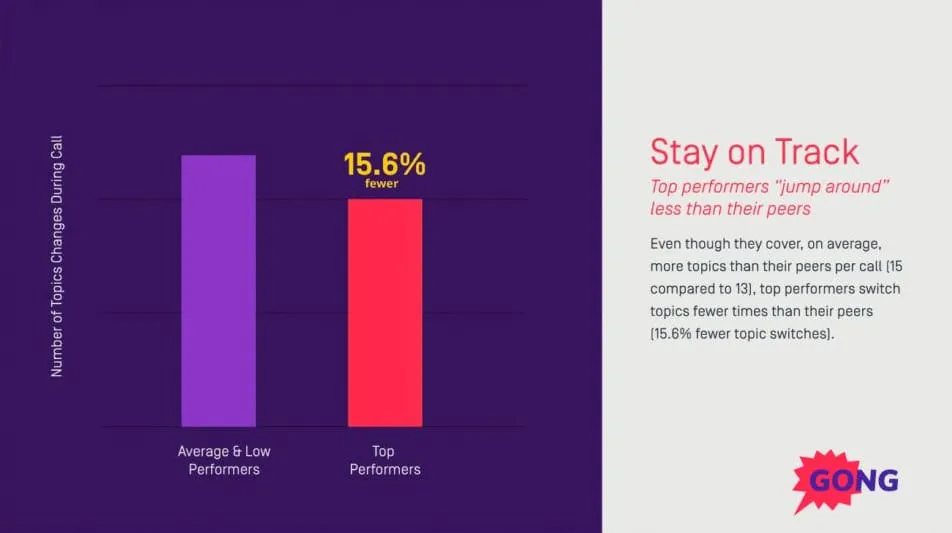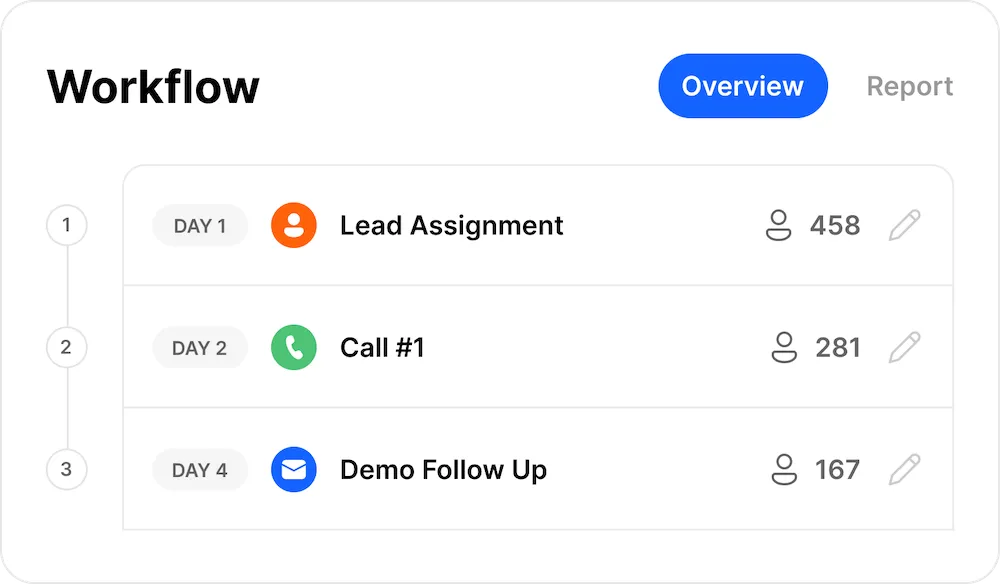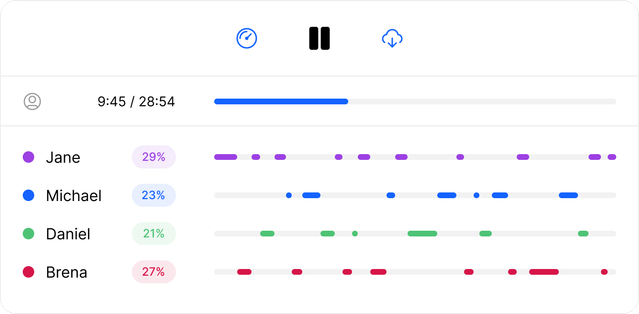
Wondering why your cold calls aren’t turning into sales? It’s easy to say that cold calling is dead and it’s time to move on—but the real problem may be your cold call script.
Research by RAIN Group shows 69 percent of decision-makers accept cold calls from new providers, and 82 percent accept meetings with sellers who reach out. Which means there is still a golden opportunity for sales reps willing to do the work and cold call their prospects.
If you’re another disappointed cold caller, consider this: Are you hitting the right pain points? Are you making the right number of follow-up calls? Are you speaking to the right people? Are you doing research on LinkedIn and other places before you hit the phones?
All of these factors will impact your success. Using the right cold call scripts will help you make the most out of the time you spend on sales calls and help you convert more interested leads into customers.
By the end of this article, you’ll have 15 cold calling script templates to use, examples you can learn from, and 11 cold calling tips to help you succeed.
Ready to be a cold calling expert?
What Is a Cold Call Script, and Why Should You Use One?
A cold call script is a pre-prepared guide that sales reps and SDRs follow when making unsolicited phone calls to potential customers.
As a salesperson, you might be thinking, “Great, but I don’t want to sound like a robot.” Well, cold call scripts aren’t meant to lock you into a conversation. They’re meant to help refine your value proposition and keep your messaging focused.
One key benefit of cold call scripts is the consistency they bring to the sales process. With them, you can deliver a unified message that works.
Moreover, sales scripts improve time efficiency by keeping conversations focused and succinct. The faster you can accurately qualify or disqualify a lead, the more volume you can handle.
By the way, if you're more of an "email person," we have a fantastic article that offers 12 well-designed B2B cold email templates.
What Do You Say When You’re Cold Calling?
Here are some of the basics that every cold calling script should include:
- Establish relatable context: Begin by introducing yourself and your company. Then, describe how your product or service addresses specific business challenges in a way that’s 100 percent benefits-focused. For example: “We help small hospitality businesses grow their online presence and amplify their social selling powers by about 10x.”
- Empower prospects with a choice: Inquire whether your offering piques their interest, giving them the autonomy to steer the conversation.
- Ask a key qualifying question: A cold call question can be as simple as “Tell me more about your current sales process.” Take some quick notes, focus on what they’re telling you, and then continue with this powerful statement: “Ok, so what I’m hearing is…” Repeating back what the prospect just told you.
- Propose a timely follow-up meeting: Suggest the next step, such as a meeting, follow-up call, or demo, highlighting the value your product delivers. Aim to schedule the meeting for the following day to maintain momentum and enthusiasm.
15 Best Cold Calling Scripts to Nail Your Next Sales Call (+ Real Cold Call Examples)
There will be many times when your base script won’t keep up with real-life conversation. While there’s no way to pre-establish a response to every possible situation, it is definitely in your best interest to have scripted responses ready for some of the more common scenarios you’ll encounter, such as getting past a gatekeeper and leaving a voicemail.
Check these top cold call scripts to improve conversions and reduce hang-ups.
Psst... Calling all cold callers! We've done the research on the top 8 sales headsets—read our review to stay ahead.
1. Base Cold Call Script
Every cold call script will start similarly. From here, you’ll dive into a short conversation with your prospect and navigate any hurdles or questions. Use the following events to add to this base and create a script for any situation.
Want to see a cold calling example to see how it works in the real world? Check our Dan Smilansky pitching his social media services on a live cold call:
Takeaways from this cold call example: Dan’s calm, natural tone keeps the conversation casual and personal, positioning himself as a LinkedIn and Facebook expert, without bragging. To model your cold calls after this, clearly state the reason for your call initially, and sell your prospects on the meeting, not the offering.
2. Cold Calling Script for Getting Through Gatekeepers
This may be enough for the gatekeeper to put your call through to your prospect’s main line, but even if you’re sent directly to voicemail, count that as a win! If you often struggle with gatekeepers, try to check your perspective; the most successful sales professionals actually appreciate gatekeepers.
3. Cold Calling Script for Finding the Decision-Maker
This script is short, sweet, and gets right to the point. You don’t want to be wasting time pitching someone who doesn’t fit your buyer persona, so if you're having a hard time figuring out who the right person is, just ask.
4. Wrong Person Sales Call Script
Sometimes you might think you’ve found the decision-maker but as the conversation progresses you realize—nope. In this case, a simple request for redirection is all you need.
5. Closed-Won Deal Script
Referrals are often one of the most valuable sources of new business. And there's no better time to ask for them than when a client’s satisfied with your product or service. This script is all about fostering that relationship and capitalizing on the success of a closed-won deal.
6. Cold Call Script for Leveraging a Mutual Connection
Leveraging a mutual connection can help in building rapport with a new prospect. By mentioning the name of someone they know and describing their positive experience with your product, you'll established instant credibility.
7. Cold Call Script for Voicemails
Not every call ends in a response. An average of 80 percent of calls go to voicemail, according to data from ZoomInfo. To create a memorable voicemail script, make an extravagant claim and back it up with real data. This kind of social proof based on real metrics can be a powerful motivator for prospects to listen to your voicemail. Even if they don’t call you back, they’ll remember you when you follow up again later.
8. Cold Call Script to Open Conversations
The real gem of this script by Darryl Bassett is the thought-provoking, open-ended question at the end. By asking an interesting question, you're encouraging the prospect to share their thoughts, ideas, or experiences. This opens the door to a more meaningful, two-way conversation.
Want to see a real example of how this works on a live call? Check out Patrick Dang using a very similar cold calling script in this video:
Takeaways from this cold call example: First, Patrick explains why he’s calling, and once he has permission, he clearly shows how he’s done his research and is familiar with the business he’s speaking to. Then, he does a great job of going through common cold call questions to discover whether the lead is a good fit for his offering.
9. Elevator Pitch Script for Real Estate Agents
By focusing on the challenges first-time homebuyers face, you're connecting with the prospect on a relatable issue. Moreover, by asking if the prospect knows someone who might need your assistance, you're opening the door to potential referrals without coming across as too pushy or salesy.
10. Cold Call Script to Introduce Yourself as a Real Estate Agent
With a subtle twist on the elevator script, this approach offers a relatable way to introduce your services to potential clients. It’s a little more personal and shares actual details about yourself—helping create a stronger connection with your prospects.
Here’s a live cold call script example from Mariah Crawford doing cold calls to For Sale By Owner homes:
Takeaways from this cold call example: Mariah's fun and natural tone goes a long way with her prospects, and she's involved in the conversation enough to respond well to whatever these people throw at her.
Mariah teaches us that a cold call sales pitch can be fun! To respond well, you need to listen well. The more comfortable you are with your pitch, the easier it will be to listen to what your prospects tell you. Keep a positive, friendly attitude in mind at all times.
Do you want to learn more about real estate marketing? Check out our article.
11. Response Script for “We already have a solution for that”
The beauty of this script lies in the fact you’re showing interest in their current solution and then transitioning to presenting an even better solution (yours). By suggesting a brief 10-minute overview, you're providing valuable information without demanding too much time. The goal isn’t to sell here—it’s to plant the seed.
12. Response Script for “I don’t have a budget for that”
By asking about the start of their new fiscal year, you show your commitment without pressuring them into immediate action. Knowing when the fiscal year begins also gives you a better chance of closing a deal when new budgets become available.
13. Response Script for “The price is too high”
Position the cost of your product as being more than worth your prospect’s investment. If you can offer a lower price to get them started, in exchange for fewer features, do it.
This shows your willingness to be flexible and as they experience the benefits of the essential features, they may be more inclined to upgrade later on. Remember: always put value ahead of price in a sales conversation.
14. Response Script for “I need to discuss this internally and will get back to you later.”
The most important part of this script is determining a date for when to circle back with the prospect. Give a couple of options and let them choose.
15. Response Script for “It’s not a good time”
Being a nuisance won’t get you the deal, but being consistent might. If someone says “It’s not a good time”, tell them you’ll call them back in a couple of days and pick up from there.
Here’s another cold calling example showing how to respond when the prospect is busy:
5 Steps to Create Your Own Cold Call Script
You can search for the perfect cold call script all day, but when nothing seems to be meeting your needs, it might be time to create your own. Let’s dive into the five steps required to do just that.
1. Know Your Audience Better than They Know Themselves
Knowing your audience means knowing things like their pain points, company size, common objections, etc. Once you know this information, you may find the need to segment certain prospects into different lists or profiles. With clearly segmented prospects, you should create segmented cold call scripts that adapt to each profile.
For example, if some of your prospects are small businesses and others are enterprise companies, you need to adapt your sales pitch to fit each business. Pay special attention to how you word your one-sentence description, and focus on specific benefits for that sector of your audience.
2. Define a Clear, Concise Elevator Pitch
A strong elevator pitch is the backbone of your cold call script. Keep it brief (10-15 seconds) and use this time to describe your product or service’s most important unique selling points.
By addressing the pain points you've identified in step one and making it clear how your offering solves those issues, you'll have a better chance of capturing your prospect’s attention.
3. List Your Best Discovery Questions
Asking the right questions during a cold call helps you uncover valuable information about your prospect’s needs. To create an effective list of discovery questions, focus on open-ended questions that encourage prospects to share more about their current situation. Things like:
- What’s your current process for dealing with [challenge]?
- What kind of results do you expect from a new solution?
- What solution are you currently using to do that? What’s working/not working with that solution?
4. Prepare Talk Tracks for Their Responses
Talk tracks are prepared answers to explain complex ideas or concepts in a simplified way.
Let’s say you have prospects bringing up similar objections or asking the same question about a particular feature. You can prepare talk tracks so that you can confidently answer those questions quickly without giving a messy response.
5. Know Your Ideal Next Steps
Having a clear goal in mind for the end of a call is vital. Identify the best possible outcome for the call, such as scheduling a follow-up meeting, sending additional information, or starting a trial.
Have a plan in place to guide the conversation toward that desired outcome. If your prospect isn't ready to commit to your ideal outcome, offer alternative next steps to ensure you maintain momentum in the sales process.
Cold Calling Tips to Boost Success Rates
Let's face it, cold calling can be a tough gig, but it’s part of a healthy sales strategy. And with the right sales tips and enough practice, you’ll quickly start noticing your close rate improve.
A word of warning: Yes, most of these cold calling tips involve some extra time or effort on your part. But trust me—a few minutes of your time spent upfront can make all the difference in the world.
Speak Slowly and Clearly
For your prospects to listen to you, they need to hear and clearly understand who you are and where you’re calling from. Otherwise, they’ll spend the rest of your pitch wondering, “Who the heck is this?”
In this case, the power of an appropriate pause can never be underestimated.
Say your name, pause. Then, say your company's name, and pause again. Allow those points to sink in before proceeding. Silence can be powerful, especially in negotiations. I once saved our company $225,000 by simply keeping my mouth shut.
Speaking slowly and pausing effectively conveys confidence and control, making prospects feel more at ease.
Smile (Because They Can Hear It)
This isn’t a myth. There are actually physiological reasons why smiling on the phone changes how you sound. The shape of your mouth and the pull on your vocal cords changes when you smile, so your voice automatically adopts a different tone.
In other words, people can quite literally hear you smiling on the phone.
Tone of voice is extremely important when selling on the phone since your voice is the only link people have to you. With a smile and the right tone, you’ll come off as friendly and helpful rather than pushy, apathetic, or aggressive.
Avoid Filler Words and Phrases
Words like “um,” “uh,” “well,” and “you know” slip into our conversations like the dust that’s collecting on your computer monitor right now. Like that dust, filler words make it difficult to see through to the point of your call. So, cleanse your pitch of filler words (and, for goodness sake, clean your monitor already)!
Of course, we know these words aren’t in your script. So, how can you stop saying them?
The best method to remove filler words from your pitch is to practice, practice, practice. And then, go practice some more. The more comfortable you are with your cold calling script, the easier you’ll get through it without adding unwelcome filler words.
Take Time for Prospect Research
Prequalifying prospects may take time, but it ensures you use the right sales script and helps build rapport. Social media platforms like LinkedIn are a great resource to gather insights on prospects, like their background, work history, and current role.
Ideally, this research happens during lead generation, but if not, invest time. Using LinkedIn to prequalify prospects lets you tailor each pitch.
Choose the Right Time
While some research shows that late morning is generally a good time to cold call, deciding on the right time to cold call is up to you. You know your prospects: so, what does their typical day look like? When is the best time for phone outreach to your prospects?
If you’re not sure, talk to current customers with whom you have a good relationship. Are these startup founders who begin their day at 5:00 AM and regularly work past 6:00 PM? Are they working remotely and getting to work a bit later to spend time with their kids before school? Do they typically take a full hour for lunch, or do they work through lunch?
Sales call timing goes beyond the hour of the day to the week, month, or quarter in which you call. Take time to understand the cycles that these businesses are going through and the timing of their goals.
Another aspect of timing your calls well has to do with inbound leads. When someone signs up for a trial on your website or fills out a form, how quickly do you respond?
According to one study, your chances of contacting a lead are 100 times greater if you call them in the first 5 minutes than calling them just 30 minutes later.
And the chances of qualifying are 21 times higher.
The point: Contact new inbound leads within the first 5 minutes.
Pro tip: Want to add new leads to your call lists faster? Close CRM integrates with inbound lead generation tools like Intercom, Drift, 99Inbound, MailChimp, Unbounce, and more, so new leads are automatically added to your lists. You can call them back at the very moment they show interest in your product.
Use the Right Sales Calling Tech to Save Time
Using the right calling technology can make your outbound sales process more efficient and less painstakingly repetitive. That’s where Power Dialers and Predictive Dialers come in—both of which are directly integrated into Close.
 |
A Power Dialer is like your sales team's best friend. It automatically dials numbers from a pre-loaded list, one call after another, ensuring that there's no time wasted on manually dialing or waiting for the next call.
A Predictive Dialer, on the other hand, is even smarter. It dials several numbers simultaneously. As soon as someone picks up, it promptly connects an available sales rep to the call. This means less time spent listening to a dial tone and more time spent closing deals.
To take it a step further, you should also be creating lead lists of similar profiles.
By doing this, you can cold call prospects with the same needs, pain points, or industry background. This approach allows reps to get into a routine and basically copy/paste their prospecting script to similar prospects.
If you need to check more outbound sales tools, we've got you covered!
Set Clear Goals and Speak with Intention
While it’s true that this should be a conversation, it’s important that you, as the sales rep, guide the conversation effectively. Research from Gong.io found that top performers switch topics 15.6 percent less frequently than average or poor performers.
 |
This means that, even though top reps seem to cover more ground, they keep their conversations clear and intentional, bringing up the right topics at the right time.
How can you do this? By following an effective call script.
When you have a clear goal for your sales call, you’ll know what you’re saying and how to direct the conversation. Remember three points you want to highlight or topics you want to cover, then take the prospect through those one step at a time.
With clear intentions and a path to follow, you’ll stop jumping topics and start having a clear, well-developed conversation.
Listen and Repeat
On a cold call, you have much less personal contact with your lead than you would in person. So, when they talk, you need to make sure you hear everything they’re saying and understand it. Without the advantage of body language and facial expressions, this becomes more of a challenge.
So, you need to take your listening a step further.
As you go through your pitch and ask open-ended questions, you want the prospect to feel understood and make sure you understand their answers (and the reasons behind their answers) very well.
Here’s an easy psychological hack to do this: repeat back their answers.
Let’s say you’ve asked about the prospect’s pain points. They respond, “The price of paper products seems to fluctuate all the time among all our different vendors.”
Then you say something like this: “So, price and supplier stability is important to you?”
And the prospect responds: “Yes, exactly.”
Now, the prospect knows that you truly understand their need. This gives them more confidence in what you say from here on out since any solution you offer should apply to this particular need.
Collaborate to Improve Your Scripts Constantly
Are you a sales manager setting up cold call scripts for your team? Remember, these should never feel stagnant. Even new customers can tell if you’re simply reusing a script in your system for years. As a team, work together to improve those scripts.
Sales leaders can set up quarterly meetings to discuss the current cold call scripts and brainstorm on improvements.
This gets the whole team involved in making sales scripts even more effective.
Know When to Throw Your Scripts Out the Window
A good sales rep knows that sometimes the script just isn’t cutting it. (But that doesn't mean you shouldn't have one—you absolutely should, talked about this here.)
A good manager knows that when his B2B sales team is creative and brings their own ideas to the table, amazing things can happen.
Just because you spend time developing an excellent sales script, doesn’t mean every rep needs to follow that script to the letter on every call.
Ultimately, every rep has a different personality and brings a different energy to each call. One thing I've seen in all my years in sales is that in the long run, being authentic will pay huge dividends.
Set up Automated Follow Up Workflows
Following up with prospects keeps you top of mind and helps maintain the momentum of the relationship—and automation lets you do this without breaking a sweat.
The majority of deals aren’t closed during the initial discovery call. So, having a solid follow-up strategy can make a huge difference.
Close Workflows allow you to create a series of personalized follow-up steps incorporating, email, SMS, and calls. Keep tweaking your outreach until you find a proven template that converts.
 |
Automated follow-up workflows save time and ensure reps maintain a consistent level of engagement with potential clients.
Take the Easy Route: Use Our Free Sales Script
The templates and tips provided above make it easy to build a cold call script that works for your business and capture your prospect’s attention.
Remember: by working collaboratively to build segmented sales scripts and knowing when to throw them out the window, your team can truly excel at cold calls.
But if you want to get a head start on creating an effective cold call script, you can download our proven script template, adapt it to your own market, and start closing more deals immediately. Give it a try!











